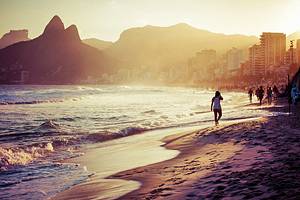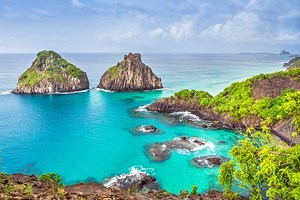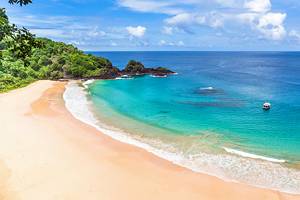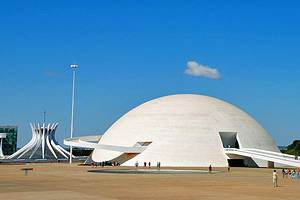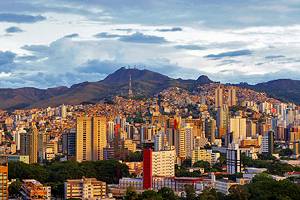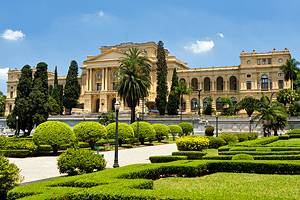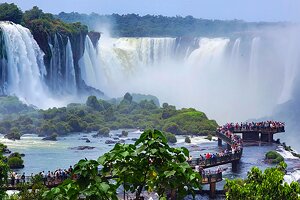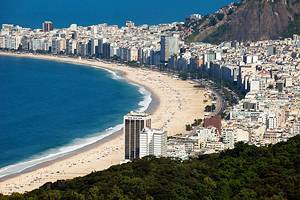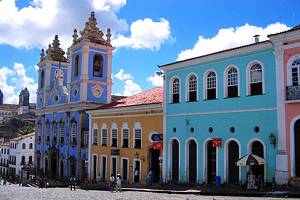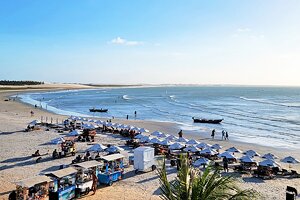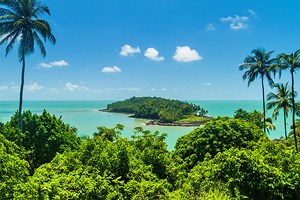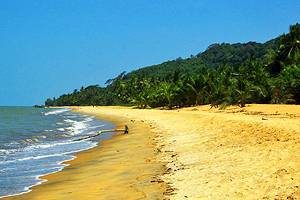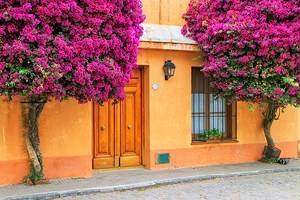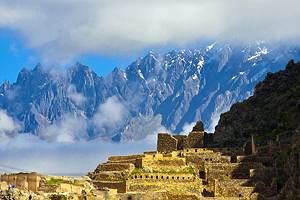Beaches in Brazil
Brazil takes up 50 percent of the land in South America and sits right on the Atlantic Ocean – so it's no surprise that it's full of golden beaches and access to some of the most beautiful coastlines in the continent.
If one of the main reasons you're heading to Brazil is to work on your tan, you won't be disappointed. Here, you can choose to lay down on the beach for hours or explore the surrounding trails and hills, and you'll end up with a golden hue either way.
You don't have to go far to find stunning beaches either – even Rio de Janeiro has two right in town. And while there are many other sandy stretches worth visiting, you can't go wrong with this list of the best beaches in Brazil.
Copacabana

Brazil's most famous beach sits right in the heart of Rio de Janeiro. If you're looking for a quiet, secluded getaway where you can enjoy the soft sands on your own, this isn't it. This is a beach for people watching (and a favorite of South American models and actors), water sports including surfing, and entertainment.
The boardwalk offers a number of cafés, restaurants, hotels, and even two historical forts, one of which houses a military museum. If you can afford the price tag, some of the best hotel room views are located right here, facing the green sea.
Crescent-shaped Copacabana is just over four kilometers long and always busy. Even families will enjoy this beach. During the New Year's Eve celebrations, thousands and thousands of people congregate on the beach to wait for midnight.
Ilha Grande

Ilha Grande (Big Island) was once used as a quarantine place for people with leprosy. When the last hospital there closed, the island was abandoned and remained wild and uninhabited for decades. Once it was rediscovered as a prime destination, efforts were made to keep development to a minimum in order to preserve the island's fauna and flora, including endangered species like the brown howler monkey.
Ilha Grande's forests are pristine; the island has no roads, and no vehicles of any kind are allowed. To reach the beach, visitors must first take a boat to Vila do Abraão, the main village on the island. From here, you can reach the island's many beaches either by boat or via a hike through tropical forest.
The main beach is Lopes Mendes, a white, sandy stretch of coastline famous for its surfing. Getting here requires an additional boat ride to Pouso followed by a 20-minute forest hike. Alternatively, you can just leave from Vila do Abraão on a seven-kilometer hike through stunning thick jungle.
Praia do Aventureiro - known to many as "the bent palm tree beach" or "the postcard beach"- is one of the most beautiful beaches on the island.
Ipanema

If the constant go-go-go energy of Copacabana seems a bit much, nearby Ipanema beach is a great place to visit instead. Perhaps one of the most famous beaches in the world (in part thanks to the unforgettable The Girl from Ipanema bossa nova song), Ipanema is classier and prettier than Copacabana, more about swimming and enjoying the sun than about non-stop action.
The area's mild winters and massive surfs make this a favorite surfing destination - during winter, the swilling of the ocean near the coast creates amazing barrels of clear, light-blue water that surfers will definitely appreciate.
Aside from the expected stalls selling food and drinks, the mosaic-like promenade here also offers an unexpected array of open-air gyms, always full of people pumping iron before stepping back onto the sand.
Just west of Ipanema and over some soft sloping hills, there's a second beach called Lebon but best known as just Posto 10, a reference to the lifeguard station number 10 located here.
For those in an active mood, the towering Dois Irmãos hill sits just minutes away and offers one of the most amazing views of Rio de Janeiro from the top.
Buzios Resort Town

Armação dos Búzios (or Buzios, as it's better known locally) sits north of Rio de Janeiro and it's a favorite among international celebrities. While the South American jet-set heads to Copacabana and other popular beaches, international stars wanting some privacy favor Buzos. The beach was a bit of a secret until Brigitte Bardot fell in love with it in the 1960s. Since then, it has become a sort of St. Tropez of South America.
Of the many beaches in town, the most famous are possibly u-shaped Ferradura Beach, which offers great snorkeling, and Geribá Beach for its great surfing and many restaurants.
Praia de Tucuns, near the south end area of town, is too windy for sunbathers, though that makes it perfect for those looking for a scenic area with smaller crowds. Because it doesn't see as much tourism as other beaches in the area, the pink sands remain soft and clean.
Jericoacoara

If you're looking for a private corner of paradise, this is where you'll find it in Brazil. Up until 1998, the area around Jericoacoara beach didn't even have electricity. That's no longer the case - though street lights are still prohibited, and you can see a sea of stars once the sun sets - and tourists now head here in search of virgin sands and quiet spots for windsurfing.
Getting to Jericoacoara beach requires a several-hours-long drive, with the last 45 minutes of it being mostly off-road through sand dunes, past little fishing villages, and along the sea.
Aside from the white sands and the great sport-friendly winds, the main attraction here is the sunset. Visitors often come here to sit on the beach to watch the sun sink straight down into the ocean.
Florianopolis

A cosmopolitan, massive island home to 42 beaches, Florianopolis has something for everybody. One of the most popular areas is Lagoa da Conceição, a large lagoon surrounded by a combination of soft white beaches and heavily forested hills. Famous as a yoga and live-healthy destination, Lagoa da Conceição offers plenty of outdoor activities, including hiking and water sports such as windsurfing and sailing.
Praia Mole (Mole Beach) nearby is a major surfing destination, but this tiny beach - just under one kilometer long - also offers plenty of hiking opportunities. A short trail departing from here will take visitors to Praia do Gravatá, one of the island's smallest islands at just 60 meters long but also one of the most secluded.
Praia dos Ingleses and Santinho Beach are also great destinations. They sit next to each other, separated by rolling golden sand dunes. Sandboarding, which was invented in Florianopolis, is quite popular here - and as the name suggests, it involves dune surfing downhill on a board.
Praia de Pipa

The quiet northern Praia de Pipa beach has been a local favorite for decades, but most international tourists are still unaware of its existence. And while the town has grown significantly in the last couple of decades, the atmosphere remains casual and laid-back. This is in part due to laws protecting the area from damaging expansion and carefully choosing what can be built here and where. Still, Pipa has a very cosmopolitan choice of hotels and restaurants that cater to both backpackers and high-end boutique travelers.
Praia de Pipa features golden sands against a background of 10-meter-high pinkish cliffs covered in green vegetation. Nearby Praia do Madeiro - just a few minutes away on foot - is a wider beach where you can rent kayaks or a sunbed, learn to surf, or just jump into the ocean for a swim.
Both beaches are often visited by dolphins.
Praia do Rosa

Praia do Rosa (Rose beach) is technically a bay with a sandy section, but the sands here are so soft and the waters so perfectly clear blue that it's no surprise it has become a popular getaway.
About seven kilometers long, Praia do Rosa is much wider when the tide is out, but even during high tide, there are plenty of things to do here, including trying water sports, swimming, or practicing your kitesurfing skills. A few restaurants and small posadas (inns) are dotted throughout the town – but generally speaking, there isn't much more to do here than enjoy nature. No parties, no nightlife.
Between July and November, southern right whales arrive here and stay near the coast to give birth. Visitors from all over the continent come over during that time to catch sight of the gentle giants.
Porto de Galinhas

Porto de Galinhas is a laid-back resort town that offers the best of two worlds: all the peace and solitude you would want in a tropical paradise paired with crystal-clear waters and soft white sands that seem to go on forever.
The main beach in the area is Porto de Galinhas beach, located right in the center of town. You'll find restaurants and food stalls here, but the palm-fringed beach remains mostly underdeveloped and it's still possible to find a little corner all to yourself. The natural pools in this area attract both swimmers and snorkelers year-round.
Only accessible by boat, the nearby Praia dos Carneiros is an even quieter beach famous for its golden sands and the tiny white church that sits right on the shoreline.
Toquinho Beach, not far away, offers all the peace you would want, plus a chance to hop on a boat for a day trip to Ilha de Santo Aleixo, a tiny uninhabited island just minutes away. If you can catch a private boat ride to the island on a weekday, chances are you'll have this corner of tropical haven all to yourself.
Maragogi

The area of Maragogi is home to Brazil's largest barrier reef, a massive nature preserve, and some of the most beautiful natural pools in the country. The pools, named Galés, are only visible during low tide. Located about six kilometers from the main stretch of beach, they are only accessible via boat.
Maragogi is located in Northeast Brazil, away from the buzz of the busiest beaches in the south. Here, river and ocean meet, offering a unique natural setting of calm, clean waters perfect for swimming but also for snorkeling and scuba diving among the coral reefs.
Since 2015, the region has been hosting a number of outdoor events, including an annual Trail Running competition.
Taipus de Fora

Turquoise blue waters, a background of coconut trees, and seven kilometers of the softest sands you'll find in Brazil make Taipus de Fora a favorite among tourists.
Famous for its crystalline tidal pools, Taipus de Fora is one of the best snorkeling and diving destinations in Brazil. The corals are stunning, and the marine life abundant, but things are equally beautiful outside the water.
Just minutes away from the shoreline, mangroves, waterfalls, and plenty of "light" jungle trails are waiting to be explored. Camping is also popular in the area, and you can pitch your tent very close to the beach for great views over the water.
The town itself (still tiny despite the boom of tourism in recent years) offers hotels, restaurants, and plenty of fun shopping in the form of markets and boutique stores.
Praia do Espelho

With a name like Mirror Beach, what else can you expect but a place with crystalline blue waters and spectacular views all around. Located in the coastal town of Porto Seguro, this hidden treasure gets a lot less crowded than beaches in major towns – and that's partly because the only way to reach it is by driving on a dirt road for an hour.
The palm-fringed beach is surrounded by reddish cliffs, and if you arrive in the evening, you can see the reflection of the moon casting on the mirrored waters.
Baia do Sancho

Located within a national marine park, this golden beach is home to a lot of wildlife, including protected turtles. Because of the UNESCO World Heritage Site status of the islands in the area, development here is basically non-existent.
That means pristine azure waters, great driving opportunities, and lush vegetation – and all in quiet surroundings, since the beach itself is not easy to reach, so you won't run into many tourists. There's plenty to explore on foot, though, including treacherous trails that take you through openings in the rocks, and precarious ladders to then reward you with stunning views.
Lopes Mendes Beach

Lopes Mendes often makes the top lists of "best beaches in the world" – and for good reason. Just three kilometers long and surrounded by palm trees, the pristine sands of this beach are flanked at each end by two hills covered in thick jungle greenery.
This makes Lopes Mendes feel completely isolated in its own corner of paradise – and as it's not that easy to reach, chances are you will get to enjoy it all on your own if you arrive in the early morning. The rough waves make it a difficult spot for swimming but a great destination for surfing.
Praia de Forno

With a name as Oven Beach, it's perhaps no surprise that the temperatures here often reach over 40 degrees Celsius in summer. But the name of this beach is actually connected to the red color of its sand, which is in turn caused by the abundance of a mineral rich in iron. This makes the sand itself get very hot, a perfect excuse to jump into the crystal-clear, blue waters for a swim.
Climbing the rocky promontory on the far left will get you to a smaller, out-of-sight beach, popular with families. You won't get a lot of solitude here, but that also means a well-developed infrastructure with plenty of places to eat (including a floating restaurant) and rent snorkeling equipment, boats, and kayaks.
Santos Beach

The municipality of Santos is home to a very unique beach, referred to by the locals as a "beach garden." This is because there's a massive five-kilometer-long garden running alongside the beach, separating the sand from a busy street filled with cafés and outdoor snack places.
Because it's located just 31 kilometers from São Paulo, this is a popular weekend destination for city folks aching for a beach escape. The beach itself is famous for its unique white/greyish sands that make for a stunning view, as well as for its flat entrance to the sea, perfect for swimming.
Ilha de Tinhare

Reachable by ferry, the car-free island of Tinhare offers a holiday paradise for those looking to relax and disconnect. A mix of soft golden sands, crystalline blue waters, and easy access to plenty of water sports provide a good balance of options for everybody.
That's not to say the island doesn't have a good infrastructure in place – there are plenty of restaurants around, and you'll find rental shops for any active pursuit you want to explore. Plus, some of the best hotels in the area sit right on the beach, so you can dig your toes into the sand as soon as you step out of your room.
Caraiva

You have to make an effort to reach Caraiva Beach, since no public transportation goes all the way there, but the peace and the charm of the area are well worth it.
Once there, pick an accommodation (hotels and campgrounds are both easily accessible) and stay for a couple of days to truly enjoy the magic here, which includes stunning starry skies, a river that flows into the sea, and waters that change from crystalline to deep blue depending on the tide. Plenty of boats offer connections to other nearby beaches.
Praia de Leao

Lions beach gets its name from a rock that looks like a sea lion lying down. It's an apt name for a beach that's considered the getaway to a very rich underwater world – and that includes not only animals but also a sunken fort.
Arrive early in the morning to grab a space on the soft white sands, and you might catch sight of the dolphins that sometimes visit the area. Development has been kept to a minimum here, so either bring a picnic or stop somewhere on your way to Praia de Leao to stock up on snacks and cold drinks.
The current can be very strong here, so swimming isn't always allowed, but you can lie back and enjoy the stunning views around.
Praia Ilha do Campeche

Located near Florianópolis, this white sandy beach is just half-a-kilometer long – but what it lacks in size, it makes up for in beauty. The island where the beach is located is not much bigger, and getting there usually means catching a ride on a local fishing boat.
While the warm turquoise waters are great for swimming, the ocean can get choppy because of the many boats around. The island itself is home to protected archeological sites – which means the number of visitors to the island is limited to less than 1,000 a day, and there is also little development here to prevent pollution.
As a result, Praia Ilha doesn't offer any overnight stay options. But for day visitors, it means a corner of quiet paradise and a chance to join guided walks through the thick vegetation of the area.
More Related Articles on PlanetWare.com
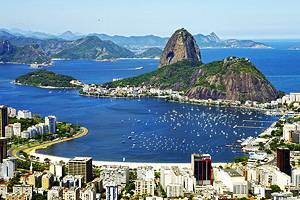
Exploring Brazil: Brazil might be best known for its beaches and Amazon, but there's plenty of other things to do in South America's largest country. Take a look at our list of tourist attractions in Brazil to get some inspiration. Brazil's largest city, São Paulo, may not have a coastline, but it has plenty to offer in the form of museums, theaters, and outdoor adventures. Find out what to see and do here in our article, Tourist Attractions in São Paulo.
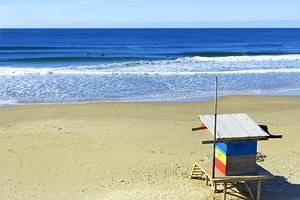
Crossing Borders: Nearby Uruguay also has plenty of beautiful beaches to visit, as you can see in our piece on the best beaches in Uruguay. Another neighboring country worth visiting is Argentina, a cosmopolitan destination with stunning natural wonders. You can read about some of the best corners to visit in our article on the tourist attractions in Argentina.


